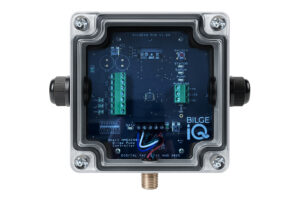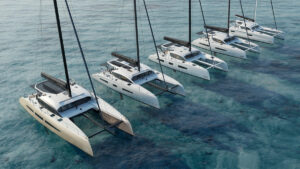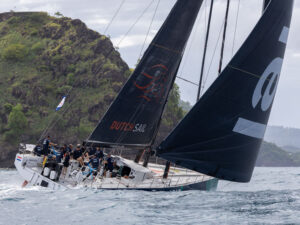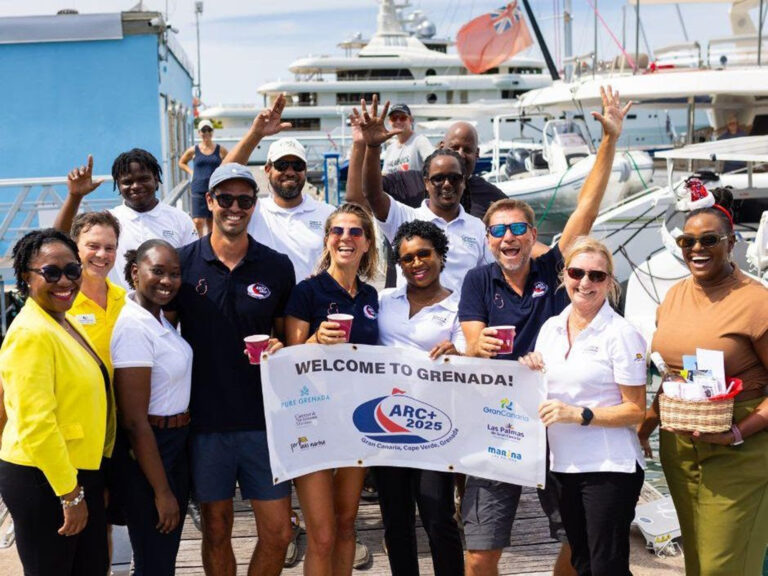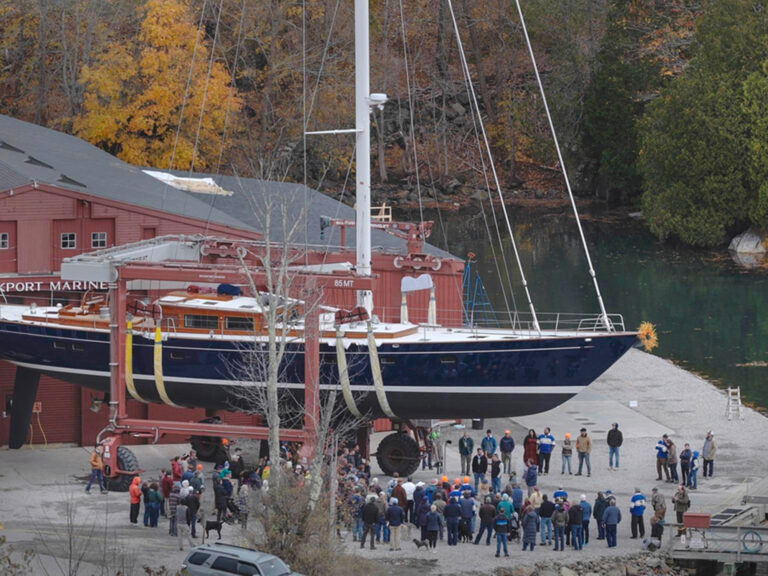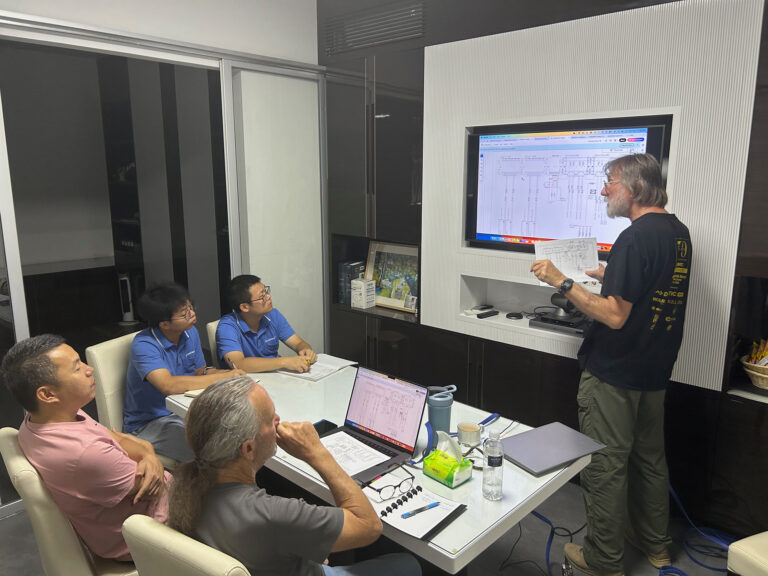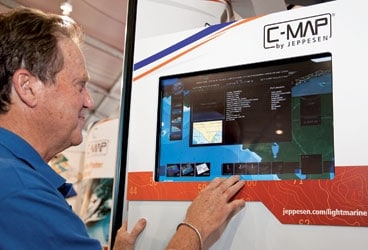
Ellison Candy 368
The recession seems to have put less hurt on marine-electronics manufacturers than on their boatbuilding brethren, and the obvious reason is that their products have improved so much in recent times that sailors still feel a need to upgrade what they already own with the latest technology. Picture anxious R&D departments burning the midnight oil to incorporate the latest features-plus the better processors, sensors, and display technologies becoming available from the wider world of electronics-lest their brand gets left behind. Thus it is that sailors will find many interesting new products to contemplate.
If you’re considering the big enchilada-a new multifunction display system-don’t skip over the all-new NSE 8- and 12-inch MFDs from Simrad (www.simradyachtingusa.com), which retail for $3,300 and $4,600 respectively. They’re related, in fact, to the HDS series that Lowrance (www.lowrance.com) introduced last year, which is a good thing in terms of excellent support for NMEA 2000 (a.k.a. SimNet) data networking and Navico Ethernet products like Broadband Radar and Sonar. But the NSE series is built to a sturdier standard and features a smart interface that includes both dedicated mode keys and a versatile rotary knob. These MFDs also have extraordinarily bright, legible, and power-efficient LED backlit screens, and a 1.6-gigahertz processor that speedily handles either the built-in Insight charts or any of the card formats from Navionics (www.navionics.com)-including the new, and useful, TurboView 3D mode. I’ve been testing a prototype NSE12 in Maine, and I’m quite impressed.
I’ve also had some on-water time with a prototype E-140 Widescreen from Raymarine (www.raymarine.com), which notably combines Raymarine’s long-evolving soft-key and keypad controls with a touch screen. That means you can perform many tasks, like selecting MARPA targets or laying out routes, more easily than ever, but with hard keys to fall back on if conditions make the touching tough. The new E Series will also offer a unique cartography choice, though it’ll come as a yet-unscheduled software update. The E Wides currently shipping include Navionics U.S. coastal charts and support for all Navionics cards, including the much-improved 3D mode; the update will allow the same Es to also support the new 4D chart format from Jeppesen C-Map (www.c-map.com), which includes a paper-chart-like raster layer, an advanced auto-routing feature, continuous updating (time is the fourth dimension), and yet another new 3D viewing mode. The Widescreen E Series come in 9-, 12-, and 14-inch display sizes, just like the C Series introduced last year, and they range from about $4,000 to $6,500.
Garmin (www.garmin.com) has two new MFD series for 2010, but they’re easier to understand as they’re essentially higher-end versions of the continuing 4000 and 5000 series. The main new feature is graphics processing so enhanced that Garmin’s dubbing the result G Motion. Need I mention that among the dramatic improvements is 3D viewing? The new GPSMap 6000 series comes in 8- and 12-inch sizes, costing $3,000 and $4,000 respectively, while the touch-screen 7000 series comes in 12- and 15-inch models, priced at $5,000 and $7,000. Incidentally, if you haven’t seen any of Garmin’s networked MFDs since last summer’s major 5.0 software update, then you’re not really familiar with their current features and performance. Garmin also refreshed all of its 4- and 5-inch plotters last summer, adding NMEA 2000 interfaces that can make for more reliable installations. Finally, all owners of recent Garmin plotters should check out HomePort, a $30 program that makes it possible to use a Garmin Vision chart card, or even a plotter’s built-in charts, for route planning, track saving, and more on your PC.
Meanwhile, partners Furuno (www.furuno.com) and MaxSea (www.maxsea.com)-which arguably jump-started the ultra-fast 3D-charting craze with the NavNet 3D hardware/software systems-have finally introduced the related MaxSea TimeZero PC charting software. MSTZ doesn’t feel like any previous MaxSea program, except for the same cruiser-friendly support for free GRIB weather data and the availability of a high-performance weather-routing module. Instead, MSTZ takes a fresh, and elegant, new approach, both in terms of interface and 2D/3D chart viewing. The Navigator version is a $450 stand-alone plotting/planning program that comes with special Time Zero versions of all U.S. NOAA raster and vector charts, along with free access to high-resolution photomaps that can “fuse” beautifully with the charts. The $1,250 Explorer version adds integration via Ethernet with a NavNet 3D system, including radar overlay and control.
MaxSea, by the way, recently assumed control of the Nobeltec charting-software line from Jeppesen, which is more interested in developing data products like C-Map 4D. Possible future fruits of this hand-off include new relationships between Nobeltec software and Furuno hardware and new access to C-Map cartography via Furuno and/or MaxSea. Meanwhile, one of the few developers that’s ignored the 3D charting phenomenon, Rosepoint Navigation (www.rosepointnav.com), is breaking new ground in another important aspect of the evolving navigation experience: the sharing of point-of-interest information among cruisers and with local-knowledge experts. Coastal Explorer 2009 came with point-of-interest sharing abilities, which have been improved, and recently introduced is a terrific relationship with Atlantic Cruising Club publications, in which some of that company’s obsessively complete marina-guide data is freely downloadable to Coastal Explorer users, while owners of the printed ACC guides get all the printed info and more geo-positioned within CE2009.
Instruments and Sensors
Tacktick (www.tacktickusa.com) has expanded its economical “Entry Level” instrument series. Like the T033 Wind system introduced last year, the T034 Depth and T035 Speed systems-each costs $516 complete-employ the wireless technology where it’s most valuable (carrying data from sensor to display), and installation requires only a 12-volt power connection. It’s also possible to use the displays and hull transmitters with some existing through-hull transducers, and all Entry Level series data can flow to Tacktick’s NMEA 0183 wireless interface box for added display on PCs or MFDs, as well as to the company’s wireless handheld remote.
Nexus (www.nexusmarine.se) offers an interesting, if little known, wireless wind transducer as well as a full line of value-oriented instruments, which include performance-oriented PC-based calibration and data logging. You may start seeing the brand more here in the States as it now has a serious U.S. distributor, Ocean Equipment (www.oceanequipment.com).
Not surprisingly, there’s new activity in the burgeoning area of NMEA 2000 sensor and display networking, which I discussed in CW’s June and August issues. Garmin, for instance, has introduced a series of $200 analog-to-NMEA2000 converters designed to be used with existing sensors-while retaining their existing gauges, if so desired-to put such data as rudder angle, water speed, and tank levels onto an N2K backbone, where it can be displayed. Data can also be used in calculations by many devices, likely including at least one of Garmin’s GMI 10 all-in-one graphic displays or MFDs. Another new display for the same sort of N2K data is the $1,000 Furuno FI507 Multi XL, which offers 60 percent more of the same super-legible and power-efficient OLED backlit numeric data presentation that’s earned raves for the original FI504 Multi.
Airmar (www.airmar.com) is introducing two new “Smart” NMEA 2000 transducers in 2010: an ST800/850 speed and temperature combo, and the B122 depth and temp combo, designed especially for steep deadrise installs. Both of these can be retrofit into many existing housings. Also offered is the U200 N2K-to-USB PC gateway, which along with the new NGT-1 from Actisense (www.actisense.com) offers most standard NMEA 2000 messages to PC programs configured to understand them, such as Coastal Explorer and Airmar’s own Weathercaster.
Lowrance, Simrad, and Maretron (www.maretron.com) have all introduced sensitive, high-spec NMEA 2000 GPS sensors that see lots of GPS channels at once and have true refresh rates of five position fixes per second. Maretron continues to build out a full line of N2K system-monitoring components, including ultrasonic tank-level sensors. The company also introduced a free and very useful system-design tool called N2KBuilder.
Worried about how to mount your new MFD or instrument systems so you can best see and/or reach them? Both Scanstrut (www.scanstrut.com) and PYI (www.pyiinc.com) have introduced tilt-and-swivel pod designs in a variety of sizes for helm, under dodger, or mast applications. And Navslide (www.navslide.no) has a nifty design for a tacking MFD, which I hope will find a manufacturer and U.S. distribution in the year ahead.
Communications and Safety
New small but powerful satellite voice and data systems-specifically OpenPort, from Iridium (www.iridium.com), and Tracphone FB150, from KVH (www.kvh.com)-were the big story of 2009, and I’m pleased to report that they’re proving themselves worth the high cost to bluewater cruisers with sufficiently flush budgets. A thorough, transpacific comparative test will be coming to these pages soon. But this year, the innovations are in smaller, more limited, satellite devices and in VHF communications.
Take SPOT (www.findmespot.com), for instance. Version Two of the popular original offers the same one-way most-anywhere satellite check-in and distress messaging and tracking, only it’s smaller, easier to use, and has a better internal GPS. The costs remain the same at $150 for hardware and $100 a year for unlimited messages, plus $50 for unlimited tracking, but one of the four message buttons can now be associated with an owner’s BoatU.S. towing account. Perhaps better yet, SPOT has announced a new product, Hybrid Universal Guardian, that’s designed specifically for boats. HUG, expected to retail for less than $500, is meant to tuck away belowdecks, where it will provide all the regular SPOT functions via a tiny remote control while also monitoring against “unauthorized movement” and an owner’s other off-boat worries.
More tentative for 2010 is Iridium’s new little short burst data modem, because rather than market it directly, the company wants it to “disappear into as many marine devices as possible.” Picture SPOT-like features built into a handheld or an MFD, only with message acknowledgements and maybe even two-way short messaging, all without coverage limitations.
The manufacturers of more traditional distress beacons are also taking advantage of smaller, better, and cheaper component technologies. The new $500 AquaLink PLB, from ACR (www.acrelectronics.com), competes nicely with the breakthrough FastFind 210, from Revere (www.reveresupply.com), once you consider inherent flotation, self-testing functionality, and actual street price.
Turning our attention to the VHF and the why-didn’t-I-think-of-that department, there’s the new $190 Galaxy 5440 masthead whip antenna from Shakespeare (www.shakespeare-marine.com), which includes a bird-resistant Windex-style apparent-wind indicator as well as a connector that makes the whip simple to remove for winter storage. The new $200 MR HH475 handheld VHF from Cobra (www.cobra.com) can also serve as a noise-cancelling Bluetooth mike for a safely stowed-away cellphone, and it includes the company’s Rewind-Say-Again feature, which means it can play back the last 20 seconds of whatever calls last broke squelch, a useful aid for those of us with deteriorating listening skills.
Garmin smartly borrowed the replay feature and upped the recording time to 90 seconds for its high-end ($700) and soon-to-ship VHF 300, a black-box unit that supports up to three of its GHS 10 handsets and about every VHF feature possible. I can verify that Garmin has done its VHF radio homework as the performance, ease of use, and NMEA 2000 integration-including the AIS features covered below-built into its existing $400 VHF 200 are impressive.
But the recent VHF introduction that really caused a blog buzz is the GX2100, from Standard Horizon (www.standardhorizon.com), which combines a full-featured Class D DSC fixed VHF with a dual-channel AIS receiver for a minimum advertised price of $400. Hence the GX2100 has four independent receivers sharing the same antenna and can not only monitor AIS traffic-graphically, and with collision alarms-but also place a direct DSC call to a target using its MMSI number. The set can output AIS data to a plotter or PC, and its sister GX2000 model ($230) can perform all the same functions using input from a boat’s existing AIS receiver or transponder. Standard Horizon has also updated its already excellent HX850S GPS/DSC/VHF handheld, adding waypoint navigation and more strobe features and thus making it a real Swiss army knife of handheld safety and day-to-day nav and coms capabilities.
There are more reasons to think that AIS usage by sailors will expand rapidly around the United States this year. Digital Yacht (www.digitalyachtusa.com), for example, has announced both the ANT200, a $300 AIS receiver that’s packed into what looks like a GPS mushroom antenna with a VHF stubby on top, and the $800 SmarterChart SC500A, a compact C-Map plotter with a 5-inch color screen and GPS and AIS receivers both built-in. There’s also talk in the industry that this smaller, better, cheaper trend will soon move into Class B and even Class A AIS transponders. In Europe, Icom (www.icomamerica.com) has been showing a heavy-duty Class B with its own display and a special DSC relationship with some of its existing VHF sets. Finally, the U.S. Coast Guard continues to forge a ruling that will extend transponder mandates to some 16,000 coastal commercial vessels that don’t currently fall under the international mandates.
Fun and more
What about onboard entertainment? Need to watch live NFL games in HD, for instance? Well, both KVH and Intellian (www.intelliantech.com) have solved DirecTV’s triple-satellite challenge, but you’ll need room for an 18- or 24-inch dome and serious finances. Also noteworthy is the latest MS-AV600 waterproof marine stereo ($500) from Fusion Audio (www.fusioncaraudio.com), which not only can output videos to your MFD/monitor but also control an iPod or an iPhone in a waterproof dock and even pause the audio while you take a call. Speaking of which, the tidal wave of recent iPhone boating apps may be the biggest onboard fun story of the year, and is arguably heading somewhere more serious, but we’ll take that up next month.
Of course, there are other interesting new gadgets that defy my simple categories. Like the First Mate (www.flir.com) from FLIR, which puts see-anything-in-pitch-dark thermal imaging-especially hot humans flailing in the water or lurking around a remote anchorage-into a $3,000, waterproof-monocular form. There are also a slew of side and forward-looking sonar advances from Navico, Interphase (www.interphase-tech.com), and Echopilot (www.echopilot.com). Plus Baron Services (www.baronservices.com) is introducing a worldwide Quicklink weather service that looks as comprehensive as the XM Satellite Weather for which it also provides weather data.
If I’ve ignored some worthy new products in this roundup, I’ll make amends-and deliver news of even newer products-at my blog, which you can visit via Cruising World’s website (www.cruising
world.com/panbo).
To see photos of Ben’s finds click the photos button at the top of the article. -Eds.
Ben Ellison is CW’s electronics editor.


